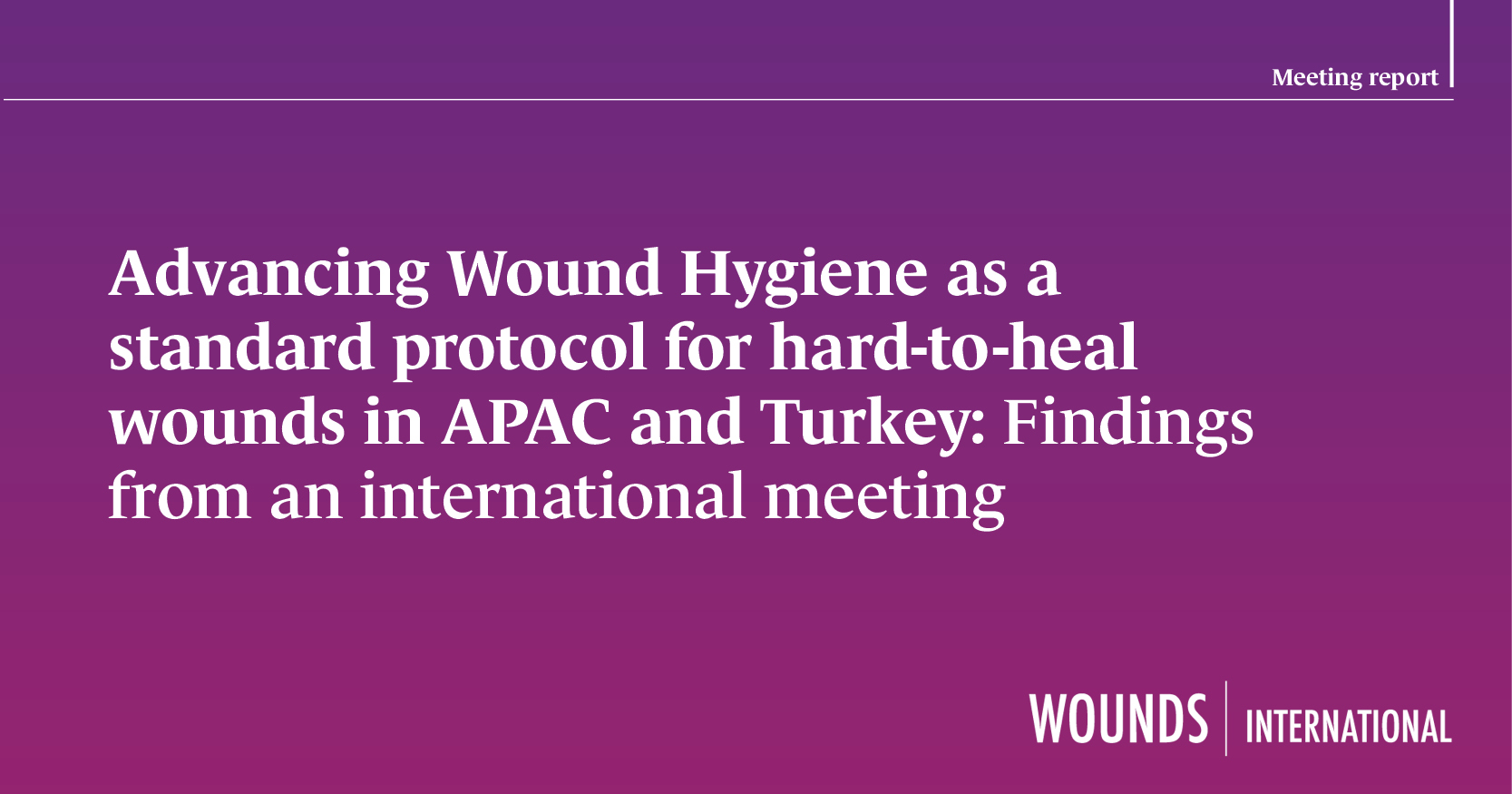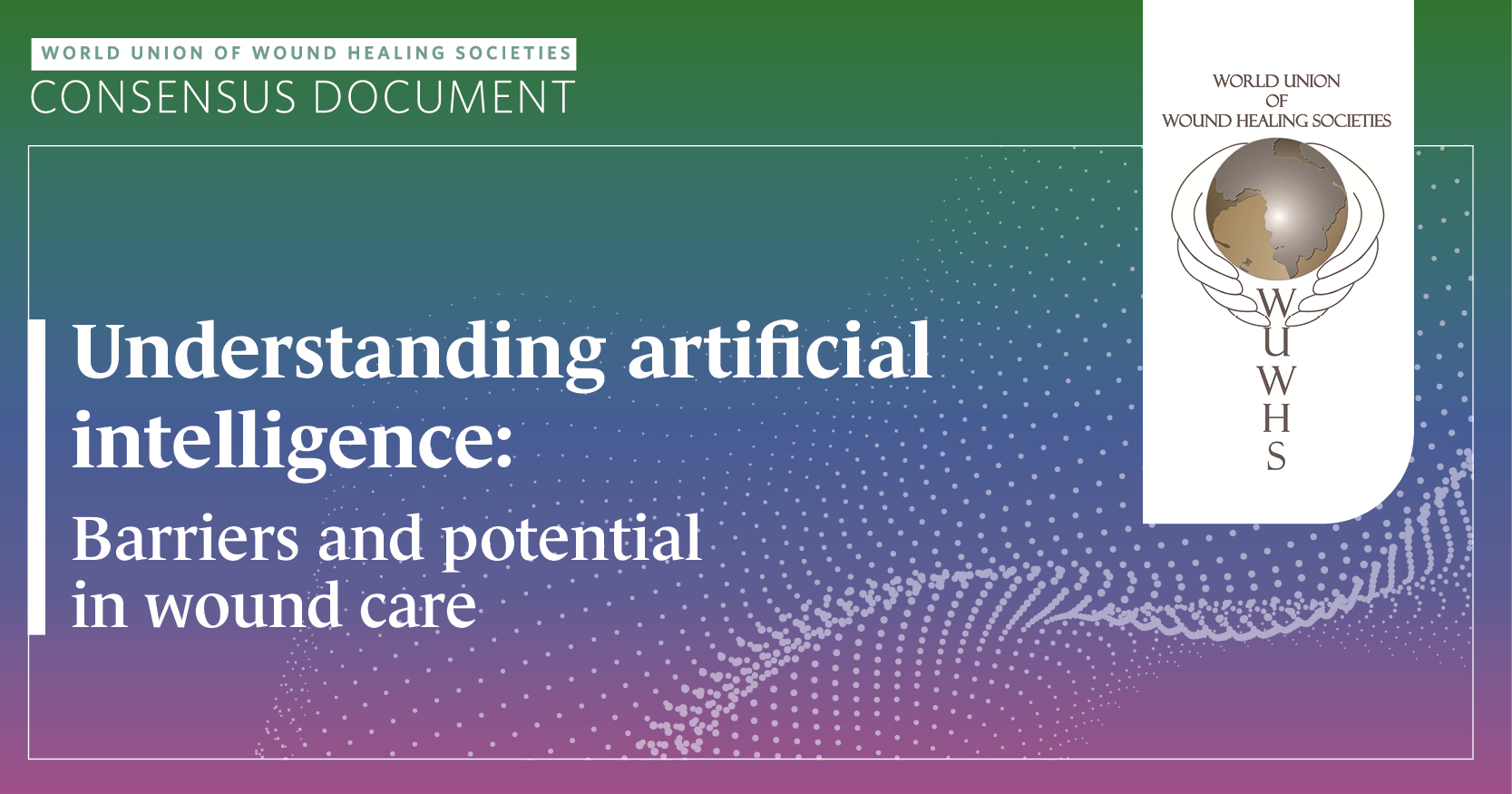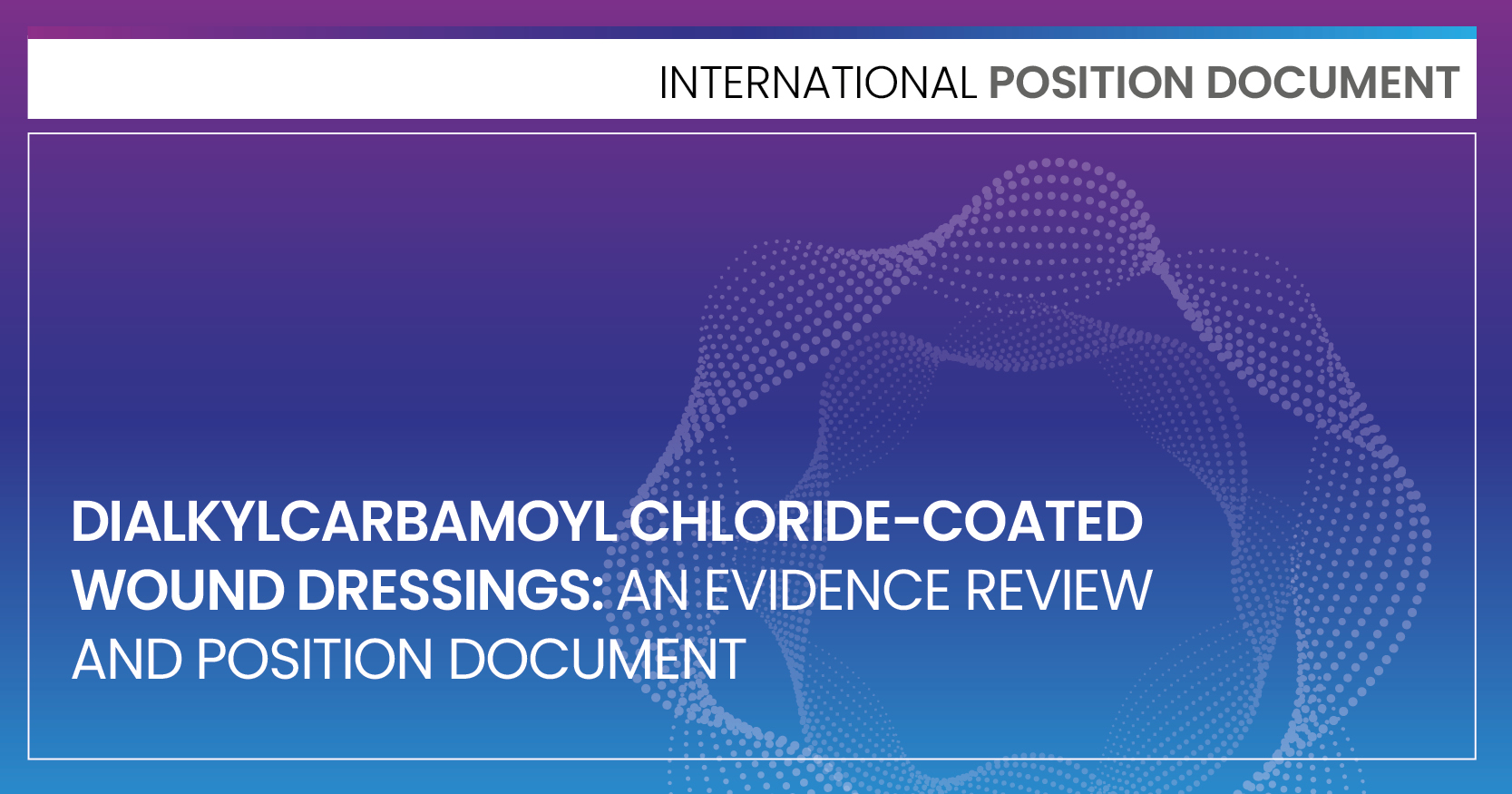Introduction
Wound Hygiene is a simple, effective concept designed as a protocol of care to support the healing of hard-to-heal wounds while addressing barriers to healing, particularly biofilm (Murphy et al, 2020). The principle is simple: just as daily hygiene practices, like washing hands and brushing teeth maintain personal health, regular application of Wound Hygiene helps maintain an optimal wound environment and prevents stagnation caused by biofilm. The protocol consists of four steps [Figure 1] that are performed consecutively and consistently at each patient visit (Murphy et al, 2022):
- Cleanse the wound and surrounding skin
- Debride the wound bed (i.e. initial debridement, if necessary, as well as maintenance debridement)
- Refashion the wound edge and ensure the skin edges align with the wound bed
- Dress the wound with biofilm-targeted therapies to support healing and prevent recurrence.
In August 2025, a panel of healthcare professionals from across the Asia-Pacific (APAC) region and Turkey convened in Beijing, China, to discuss strategies for adopting Wound Hygiene as a standard approach for treating hard-to-heal wounds. The meeting was chaired by Professor Dr Harikrishna KR Nair and brought together an interdisciplinary panel of clinicians, surgeons, nurse practitioners and researchers representing over two centuries of collective experience in wound care.
The panel highlighted that while the Wound Hygiene Protocol is conceptually straightforward, it requires intentional integration into clinical workflows to achieve consistency and efficacy. Most clinicians on the panel already practice elements of Wound Hygiene without formally recognising it as a defined protocol – for example, therapeutically cleansing wounds (for more information see International Wound Infection Institute [IWII], 2025 and Figure 2), removing non-viable tissue and applying dressings are part of their standard of care. However, without recognising these steps as components of a unified evidence-based protocol, their application can be inconsistent, vary between practitioners and lack systematic documentation.
By formally defining and labelling these practices as ‘Wound Hygiene,’ clinicians can ensure that each is applied consistently and with a clear rationale, ultimately improving patient outcomes and enabling better communication across multidisciplinary teams. Its simplicity and adaptability make it transferable across diverse clinical settings, clinical skill levels and patient populations.
Importantly, Wound Hygiene is not intended to replace or conflict with established wound management frameworks such as T.I.M.E. (Schultz et al, 2003), T.I.M.E.R.S. (Atkin et al, 2019), Wound Balance (Wounds International, 2023) or M.O.I.S.T. (Dissemond et al, 2022). Rather, it complements these approaches, offering a straightforward, practical routine that reinforces their principles and can be readily integrated into comprehensive evidence-based care.
Terminology and framing of hard-to-heal wounds
The terminology used to describe wounds has important clinical and psychosocial implications. Traditionally, wounds that fail to respond to evidence-based standard care have been described as “chronic wounds.” Normal healing is typically indicated by a ≥40% reduction in wound area (Leaper and Durani, 2008; Gwilym et al, 2022) or evidence of re-epithelialisation after four weeks of optimal therapy (Vowden and Vowden, 2016).
However, the term “chronic wound” has been criticised for its ambiguity regarding duration (Bernell and Howard, 2016; Kyaw et al, 2018; Murphy et al, 2019; 2020) and for implying permanence or inherent unresolvability. This framing can undermine patient hope and may inadvertently influence healthcare payers, potentially limiting access to effective interventions.
Increasingly, clinicians prefer the term “hard-to-heal wound.” This terminology conveys that the wound is complex but still manageable with appropriate, evidence-based care. It more accurately reflects wounds that have stalled in the normal healing process, emphasising delays or disruptions in tissue repair rather than presenting the wound as fixed. The term fosters optimism for patients, supports a patient-centred approach and can influence clinical decision-making by encouraging early intervention, timely referral for advanced therapies and avoidance of therapeutic inertia.
In English, a clear distinction exists between “hard-to-heal” and “chronic” wounds. In some languages, such as Mandarin Chinese, both concepts are translated into a single term, potentially obscuring the distinction between wounds that are slow to progress but reversible and those that are truly chronic. This linguistic overlap carries important implications for clinical practice, health policy and patient engagement.
Ultimately, the choice of terminology should consider context and audience. Many wound care specialists prefer “hard-to-heal” because it combines clinical accuracy with a constructive, hopeful perspective, supporting appropriate care and positive patient outcomes.
Biofilm and the rationale for Wound Hygiene
At the core of Wound Hygiene is the management of biofilm, a primary local barrier to healing in almost all open wounds. Biofilms are typically polymicrobial, containing clusters of different bacteria growing at variable rates, which makes them highly resistant to treatment (Fletcher et al, 2020). While research continues into their exact role in delayed healing, it is now widely accepted that most hard-to-heal wounds contain biofilm. Estimates suggest prevalence between 60% and 100%, with the true figure likely approaching 100% (Bjarnsholt et al, 2017; Malone et al, 2017).
Panellists emphasised that Wound Hygiene is essentially biofilm-based wound care in practice: routine cleansing and disruption of biofilm through simple, repeatable steps. Yet despite strong supporting evidence, this connection is not always recognised in everyday practice, contributing to inconsistent adoption. Reinforcing the link between biofilm science and Wound Hygiene through education, clinical guidelines and policy was viewed as essential for driving standardisation of care.
Defining successful implementation
Across the APAC region and Turkey, successful implementation of Wound Hygiene was consistently described as moving beyond an optional, specialist-led practice to a routine, standardised protocol applied at every dressing change. The panel emphasised that the protocol should be adoptable by clinicians across the full spectrum of skill levels, from generalist or primary care providers to specialist wound care practitioners, ensuring that its principles can be consistently applied across tertiary hospitals, community settings and primary care.
Barriers to implementation
The adoption of Wound Hygiene across APAC and Turkey is shaped by barriers at the patient, provider and system levels.
At the patient level, limited awareness, reliance on traditional practices and poor engagement and/or adherence to recommended care were identified as major barriers to Wound Hygiene adoption. In many cases, patients may delay seeking professional care until complications, such as infection, tissue breakdown or other structural skin damage have developed, further reducing the likelihood of timely intervention and undermining healing outcomes. Beyond clinical management, Wound Hygiene offers an opportunity to engage patients and communities through education, reinforcing the idea that timely presentation and early intervention is important.
At the provider level, variation in training and restrictions on scope of practice create inconsistent delivery of the Wound Hygiene Protocol. For example, while many clinicians already routinely cleanse, debride and dress wounds, these steps are not always recognised or implemented within a structured framework. In some jurisdictions, debridement is typically reserved for specialists with the appropriate training and competencies [Box 1], reflecting a historical perception that it requires specialist skills. This perception likely arises because debridement is often associated with sharp or surgical techniques. In practice, however, a range of debridement methods, such as autolytic or mechanical, are less invasive, generally require less training and are more widely used. Selection of the appropriate method should be guided by individual patient and wound characteristics, with different techniques necessitating varying levels of clinician expertise. Certain methods can safely be performed by generalist or non-specialist staff (Murphy et al, 2019; Mayer et al, 2024).
Despite these challenges, Wound Hygiene was consistently described as simple, adaptable and teachable. Importantly, the underlying principles can be applied across a range of contexts, including resource-constrained environments, using basic tools such as saline for cleansing and gauze for mechanical disruption of biofilm. The intensity of Wound Hygiene steps can be adjusted according to the wounds stage and tissue type within the healing trajectory, as well as the skill level of the clinician performing them (Murphy et al, 2022).
At the system level, reimbursement gaps and policy frameworks were identified as critical determinants of uptake. Advanced dressings and cleansing solutions for hard-to-heal wounds are often unreimbursed. Documentation practices also vary widely, with few standardised tools available to capture wound assessment, progress and interventions, which undermines continuity and accountability. Infrastructure disparities exacerbate these issues: rural and resource-limited settings may lack even basic wound care supplies, while busy tertiary centres struggle with staffing and workflow constraints.
Generating evidence and building consensus
For Wound Hygiene to transition from concept to standard of care, the panel emphasised the importance of value-based evidence. Real-world outcomes, such as time-to-healing, recurrence rates and infection-related complications were regarded as most persuasive for clinicians and policy makers, while economic data demonstrating reduced hospitalisations and more efficient use of advanced dressings were seen as influential for administrators.
Conclusions from a 2024 prospective, real-world analysis of 693 hard-to-heal wounds across six European countries demonstrated the impact of Wound Hygiene Protocol. Wounds that were static or deteriorating (66%) decreased to 5%, with 94% showing improvement or healing. This quality improvement programme, which embedded the Wound Hygiene Protocol through a structured education programme, also found that nearly all clinicians (98.8%) reported they would continue to adopt the Wound Hygiene protocol. These findings provide strong evidence that adoption is both feasible and effective. This example underscores that adoption is both feasible and scalable when supported by training and systematic data collection.
Building on this, panellists outlined several strategies to strengthen real-world evidence generation. Quality improvement programmes could embed Wound Hygiene into structured review cycles (e.g. two- and four-week assessments) to monitor healing trajectories and prompt timely interventions. Digital innovations, including wound photography, 3D measurement tools and autofluorescence imaging were seen as key to improving the consistency and objectivity of documentation. Agreement on a minimal dataset, capturing core variables such as wound type, size, duration, infection status and interventions, would further enable comparability across centres and countries. Finally, ethics and governance alignment, particularly regionally tailored frameworks for data consent and sharing, was viewed as essential to enable multi-country initiatives.
The panel additionally agreed on a pragmatic, phased approach to evidence generation. Initial efforts could focus on small-scale studies, such as case series or cohort analyses, which are recognised as a valid real-world paradigm. These early initiatives can provide proof-of-concept and build capacity, laying the groundwork for larger initiatives such as a formal Wound Hygiene registry as experience, infrastructure and data governance frameworks mature.
Yet several barriers to real-world evidence collection were highlighted. Ethical approval processes were viewed as complex and time-consuming, particularly when multi-country collaborations were considered. Technical barriers, including inconsistent terminology, non-standardised documentation and variability in digital platforms, limit the comparability of data across institutions. In several contexts, infrastructure limitations such as limited digitisation or non-integrated documentation systems further constrain data capture. These issues are compounded by the time burden placed on busy clinicians, alongside the challenges of patient consent and variable data governance frameworks.
Accreditation pathways for Wound Hygiene in the APAC region and Turkey
The expansion of Wound Hygiene from a clinical concept to a recognised standard of care requires not only robust evidence but also formal accreditation structures to ensure quality and consistency. Accreditation frameworks can embed Wound Hygiene within healthcare systems, elevate professional competence and support long-term adoption. Panellists identified several priorities for advancing accreditation strategies across the APAC region and Turkey.
Defining core competencies
The foundation of accreditation lies in defining the skills required to deliver Wound Hygiene effectively. Core competencies should differentiate between generalist providers (e.g. primary care physicians and community nurses) and specialist wound care practitioners, while also recognising the role of allied health professionals. In some jurisdictions, questions remain regarding the participation of pharmacists or podiatrists in Wound Hygiene delivery. A tiered competency framework, ranging from introductory awareness to advanced specialist practice, was considered the most pragmatic approach, reflecting the heterogeneity of healthcare systems across the region.
Models of accreditation
Accreditation models differ across countries, with government-led pathways offering authority and consistency but often limited by slow, bureaucratic processes. Professional society-led accreditation, in contrast, provides agility and clinical alignment but may lack formal recognition at the system level. A hybrid approach, where professional societies develop and pilot training modules that can later be endorsed by regulatory authorities was identified as the most feasible near-term strategy.
Structure and delivery of accredited training
Effective accreditation must be reinforced by structured education. Education was consistently highlighted as a priority, both to strengthen the conceptual understanding of Wound Hygiene, particularly its role in biofilm management, and to improve the consistency with which its four steps are applied. It would require all clinicians, from specialists, nurses and community health workers to be confident and competent in the four steps. Wound Hygiene should not be treated as “extra work” but integrated into existing workflows and curricula, supported by ongoing professional development, workshops and postgraduate training.
Suggested models that could help with education included blended digital and in-person training, short courses embedded within existing nursing or medical curricula, and competency-based assessments linked to certification or audit processes. Local endorsement, for example by national nursing or surgical societies, was viewed as critical to building practitioner trust and legitimacy. These models can be adapted to diverse regional contexts, with some settings emphasising the need for locally endorsed courses aligned with existing credentials, while others face challenges in securing government-level accreditation and instead rely on professional societies as key partners.
Alignment with international frameworks The World Union of Wound Healing Societies (WUWHS) and other international bodies already provide evidence-based frameworks for wound care. Panellists recommended integrating Wound Hygiene into these structures, or aligning national curricula with WUWHS modules, as a way of accelerating adoption while ensuring global consistency. Local adaptation would remain essential, but anchoring accreditation in internationally recognised frameworks could strengthen the case for policy-level endorsement.
Strategic priorities for the region
A stepwise approach was recommended to advance accreditation. At the local level, small-scale training pilots endorsed by national societies should be initiated and their outcomes documented. At the regional level, an APAC-wide consensus framework, modelled on European precedents, could provide coherence and facilitate knowledge exchange. At the national level, engagement with regulatory authorities will be required to embed Wound Hygiene into accreditation systems, professional curricula and reimbursement structures.
Future directions
Looking forward, participants emphasised that progress will require momentum across regional, national and local levels. Regional collaborations could provide unifying frameworks and cross-border learning, national societies can drive integration into guidelines and accreditation pathways, and local publications and case reports can showcase early successes. Crucially, Wound Hygiene should not be regarded solely as a clinical protocol but as a broader quality movement in wound care. Its simplicity and adaptability make it accessible across disciplines, while its scientific foundation in biofilm disruption provides a compelling rationale for standardisation. Success is achieved when Wound Hygiene becomes “second nature,” akin to universal practices such as hand hygiene, rather than an optional or situational intervention. With sustained education, evidence generation and policy engagement, Wound Hygiene has the potential to transform the management of hard-to-heal wounds across APAC and Turkey.





